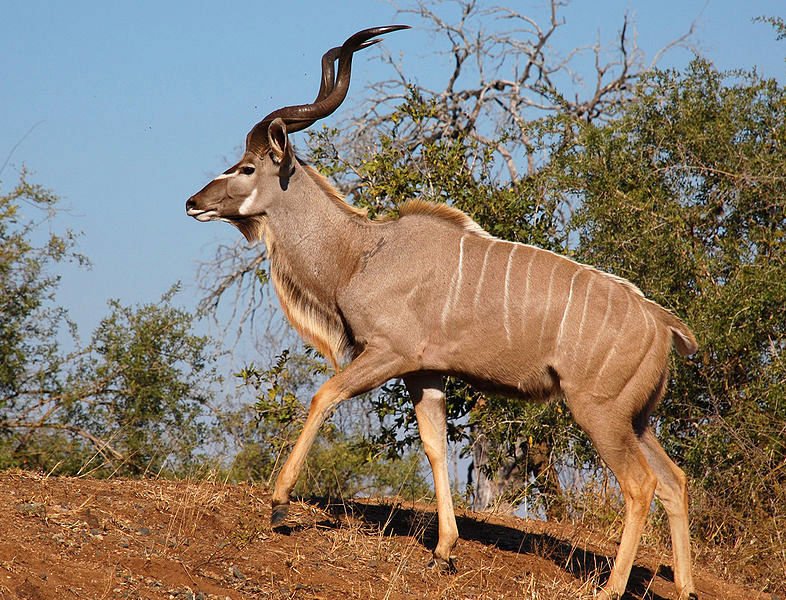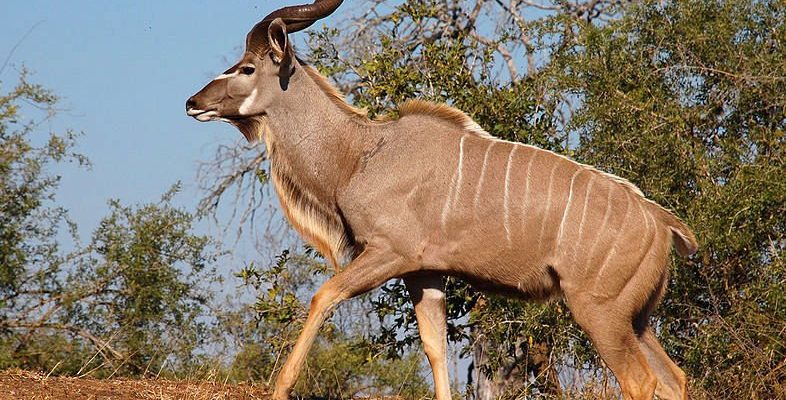
Let’s take a moment to dive deep into what makes kudus so fascinating, while also clearing up some of the confusion that often accompanies these magnificent creatures. Kind of like having a chat with a well-informed friend over coffee, I’ll break down various ideas about kudus and separate fact from fiction.
Myth
You might think that kudus are social animals, living in large herds like some other antelopes. Here’s the thing: while it’s true that they can be seen together, they’re not always the social butterflies of the savanna. In the wild, kudus tend to be more solitary or form small groups, especially females with their young. Males, on the other hand, often prefer to roam alone.
These solitary habits help them stay safe from predators. Imagine if you were trying to hide in a crowd; it would be much tougher than if you were tucked away in a quiet corner. Kudus rely on their excellent camouflage and keen senses to navigate their environments, so being alone can actually be an advantage.
Why Solitude Works
Kudus have adapted to their habitat in a way that balances safety and resource availability. Here are a few reasons why solitude can be beneficial:
- Camouflage: Their greyish-brown coats help them blend into their surroundings.
- Food Resources: When they’re alone, they can graze on leaves and shrubs without competition.
- Predator Avoidance: Fewer eyes on them can mean less chance of being spotted by predators.
Let’s not forget that while they don’t form large herds, kudus do communicate with one another through calls and body language when they do encounter each other.
Myth
Another common misconception is that all kudus sport identical horns. While it’s easy to assume otherwise given their spiral design, here’s where it gets interesting: horns vary significantly between males and females. Male kudus grow those impressive, twisted horns that can reach up to 6 feet long, while female kudus don’t have horns at all.
These horns serve a crucial purpose in male competition. Imagine the ultimate showdown in nature—two males locking horns, literally, to establish dominance or attract mates. The shape and length of the horns can play a role in the outcome of these confrontations, adding an extra layer to the drama of animal life.
What Makes Their Horns Unique
Kudu horns are not just for show; they’re fascinating from a biological perspective as well. Here are some fun facts about them:
- Growth: Horns are made of keratin, the same substance as human hair and nails, and grow continuously throughout a male’s life.
- Age Indicator: You can often gauge a male’s age by examining the number of spirals on their horns—more spirals usually mean an older kudu.
- Defense Mechanism: They can be used to fend off predators and rivals during fights.
So, while all kudus share certain characteristics, their horns are a prime example of nature’s diversity.
Myth
Have you ever watched a kudu bound gracefully through the bush? You might be surprised to learn that many people think kudus aren’t great jumpers. Honestly, this couldn’t be farther from the truth! Kudus are phenomenal jumpers and can leap up to 6 feet high and cover distances of over 30 feet in a single bound.
This incredible ability is key to their survival. When faced with predators—like lions and hyenas—the ability to leap over obstacles can be the difference between life and death.
How They Use Their Jumping Skills
Kudus use their strength and agility to navigate their environments in several ways:
- Evading Predators: Quick, high jumps can confuse and elude predators.
- Crossing Terrain: Ability to jump helps them navigate the dense bush where they live.
- Accessing Food: They can reach higher branches, allowing them to graze on leaves that other animals can’t.
So, if you ever find yourself doubting a kudu’s athletic prowess, just take a look at them in action. They’re nature’s own athletes!
Myth
You might think kudus are strictly native to Africa, and while they are primarily found in the southern and eastern regions, that’s not the whole story. Their range also includes some specific areas of the Middle East, particularly in countries like Yemen. It might surprise you!
Plus, kudus are often found in a variety of habitats, from woodlands to savannas. They prefer areas with sufficient cover and an abundance of food, so while Africa is their main stomping ground, they aren’t entirely limited to that continent.
Where to Spot Kudus
If you’re hoping to catch a glimpse of these beauties, you might want to explore the following regions:
- South Africa: Kruger National Park is a great spot.
- Namibia: Etosha National Park has a healthy kudu population.
- East Africa: You can find them in various reserves in Kenya and Tanzania.
So, if you’re planning a wildlife safari, keep an eye out for these incredible creatures!
Myth
Some folks believe that kudus are thriving and widely abundant, but this is a bit misleading. While they are not classified as endangered, their populations are under threat due to habitat loss and hunting. The problem often stems from human encroachment on their territories, which has led to decreased food sources and increased conflict with humans.
Conservation efforts are crucial to ensure that kudus continue to thrive in their natural habitats. It’s not just about saving a species; it’s about preserving the intricate web of life that includes kudus and many other creatures that depend on similar ecosystems.
Supporting Kudu Conservation
Here are a few ways you can help support kudu conservation efforts:
- Support Wildlife Reserves: Visiting or donating to reserves can help protect their habitats.
- Spread Awareness: Educating others about the importance of these animals can foster more support for conservation.
- Responsible Tourism: Engaging in responsible tourism helps minimize human impact on their habitats.
By being proactive about conservation, we can ensure that kudus remain part of our world for generations to come.
In conclusion, kudus are not just beautiful animals; they are complex creatures with unique lifestyles and challenges. By dismantling these common myths and misconceptions, we can better appreciate and understand them. So next time you think about kudus, remember: they’re not just magnificent—they’re survivors adapting in a constantly changing world.

